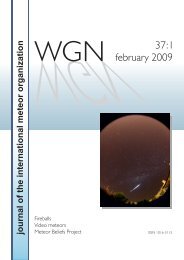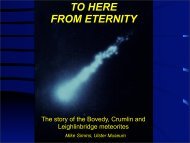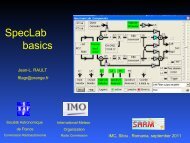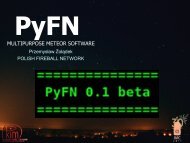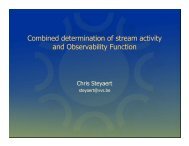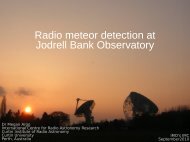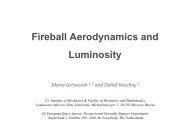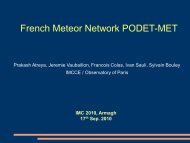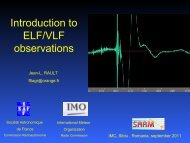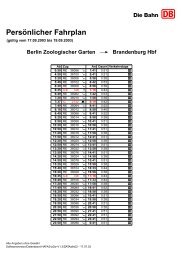Chris Steyaert: Meteor Trajectory from Multiple Station Head Echo ...
Chris Steyaert: Meteor Trajectory from Multiple Station Head Echo ...
Chris Steyaert: Meteor Trajectory from Multiple Station Head Echo ...
Create successful ePaper yourself
Turn your PDF publications into a flip-book with our unique Google optimized e-Paper software.
<strong>Meteor</strong> <strong>Trajectory</strong> <strong>from</strong> <strong>Multiple</strong> <strong>Station</strong> <strong>Head</strong> <strong>Echo</strong><br />
Doppler Observations<br />
<strong>Chris</strong> <strong>Steyaert</strong><br />
steyaert@vvs.be
Principle<br />
• Reflection on the path (mirror)<br />
• Reflection on the head<br />
Armagh september 2010 VVS <strong>Chris</strong> <strong>Steyaert</strong><br />
2
Typical spectrogram<br />
Armagh september 2010 VVS <strong>Chris</strong> <strong>Steyaert</strong><br />
3
Simulated Doppler for observed fireball<br />
Armagh september 2010 VVS <strong>Chris</strong> <strong>Steyaert</strong><br />
4
Detailed head echo<br />
Analysing the .wav file<br />
Armagh september 2010 VVS <strong>Chris</strong> <strong>Steyaert</strong><br />
5
Earlier research<br />
• Manning et al., 1949.<br />
"Radio Doppler Investigation of <strong>Meteor</strong>ic Heights and<br />
Velocities".<br />
Journal of Applied Physics, Vol. 20, p.475-479.<br />
• Richardson, J. and Kuneth W. (1998).<br />
"Revisiting the Radio Doppler effect for forwardscatter<br />
meteor head echoes".<br />
WGN, Journal of the IMO. “26, 117-130”.<br />
Armagh september 2010 VVS <strong>Chris</strong> <strong>Steyaert</strong><br />
6
Some maths<br />
6 observations →<br />
position M (3 parameters) and velocity vector v (another 3) can<br />
be determined<br />
Armagh september 2010 VVS <strong>Chris</strong> <strong>Steyaert</strong><br />
7
VVS beacon /<br />
receiving network<br />
Armagh september 2010 VVS <strong>Chris</strong> <strong>Steyaert</strong><br />
8
Worked out real case<br />
12 Dec 2009, 20h38 UT Geminid<br />
sure about identification?<br />
Armagh september 2010 VVS <strong>Chris</strong> <strong>Steyaert</strong><br />
9
standard Geminids radiant<br />
α = 113 º, δ = +32 º<br />
at the location of the beacon:<br />
Az = 257 º, h = 34 º<br />
Armagh september 2010 VVS <strong>Chris</strong> <strong>Steyaert</strong><br />
10
Numerical procedure<br />
• ‘Simplified ‘ procedure for streams:<br />
– velocity vector is known (v = 34400 m/s)<br />
– starting value for M = (0, 0, 90000)<br />
• Miminize the Doppler and Doppler rate errors<br />
M = (-16000, -18000, 96000) at t = 0<br />
• For the mid point of the head echoes:<br />
• Why Coussens no HE?<br />
Armagh september 2010 VVS <strong>Chris</strong> <strong>Steyaert</strong><br />
11
Sensitivity analysis<br />
• Error source<br />
– timing accuracy (NTP synchronised)<br />
– outlier removal?<br />
• Monte Carlo simulation<br />
– Std dev 5 ms<br />
Armagh september 2010 VVS <strong>Chris</strong> <strong>Steyaert</strong><br />
12
Simulation results<br />
Armagh september 2010 VVS <strong>Chris</strong> <strong>Steyaert</strong><br />
13
Conclusions / the future<br />
• Accuracy<br />
– Several km, strongly depending on geometry of the receivers<br />
around the transmitter<br />
– Sensitive (few %) to speed<br />
• Need better time reference<br />
• Full procedure for non-stream meteors<br />
• Number: average 10 / day ? Statistics of head echoes<br />
• Automate the analysis<br />
Armagh september 2010 VVS <strong>Chris</strong> <strong>Steyaert</strong><br />
14
Thanks to<br />
• The beacon observers<br />
• BIPT (Belgian Inst. Post and Telecom)<br />
• Felix Verbelen<br />
• Gaspard De Wilde<br />
• David Entwistle<br />
• Astrolab IRIS, Zillebeke<br />
• VVS<br />
• Pierre Terrier<br />
Armagh september 2010 VVS <strong>Chris</strong> <strong>Steyaert</strong><br />
15



